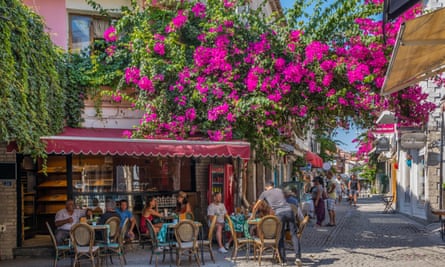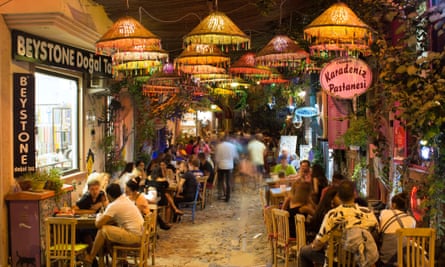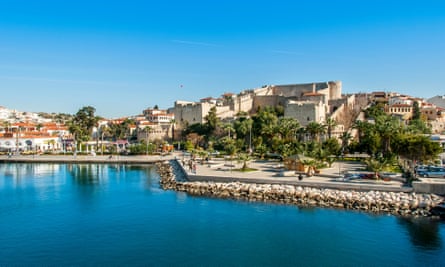It was on a trip to Cunda island that I realised the big difference between Turkey’s Aegean region and the glittering Mediterranean coastline of the south. The Med resorts are filled with foreign holidaymakers, flooding in through Bodrum and Dalaman.
Farther north, most visitors are Turkish, so instead of adapting to the needs and desires of European holidaymakers, the towns and villages that dot the coastline offer an authentic slice of Turkish life.
The Aegean region is different in other ways too: waves of immigration, a westerly facing aspect and the proximity of several Greek islands gives it a more cosmopolitan feel, with the city of İzmir often referred to as Turkey’s San Francisco. Not all of the places below are somewhere to stay for a week, but knitting together two or three offers the chance to really get under the skin of this extraordinary country.
Alaçatı

On summer weekends, this picture-perfect former Greek fishing village throngs with couples from Istanbul and İzmir, lured by the idyllic mix of hip hotels, bougainvillea-draped streets and cocktail bars, housed in restored Ottoman houses and Greek-style stone mansions. Set slightly inland, it’s an easy 10-minute drive or dolmuş ride to the small resort town of Ilıca, with its long sandy beach.
Alaçatı is famous as Turkey’s favourite foodie town, with its own food festival in March and about 200 restaurants scattered through the streets. Many still cleave to the traditional way of ordering; no menu, just a trip to the cold bar to select a choice of meze (freshly made salads) and fresh fish or succulent kebabs. My favourite is Papazz (mains about £17), run by the delightful Murat and his family, who makes a wonderfully moreish sourdough and succulent, tangy lamb, closely followed by Fava for its delicious, traditional meze (mains from £12), and Sota (mains about £20) for excellent sushi, ceviche and oysters.
Hotels in Alaçatı come and go but the İncirliev (doubles from £104 B&B) is an institution; two old stone houses with an oasis-like shady garden, run by the charming Sabahat and her husband, Osman.
Cunda

It took 25 years of visiting Turkey before I made it to this small island, linked by causeway to the pretty town of Ayvalık – but it instantly became a favourite. A Greek fishing village until 1923, most of the architecture has remained untouched, pairing a Greek island feel with an unmistakably Turkish atmosphere. Cunda’s popularity as a weekend retreat from Istanbul and İzmir has given rise to a clutch of chic cafes and cocktail bars alongside traditional restaurants, specialist food shops – olive oil, cheeses, spices – and small boutiques.
With no beach, Cunda is more of a place to spend a couple of days than a week, pottering across to Ayvalık for an afternoon ramble around the antique shops, stopping for coffee and simit (a kind of bagel-pretzel hybrid) under the vines at the Kahramanlar bakery – one of the oldest in town. It’s in the evenings when Cunda is at its best; it’s wonderful to watch the sunset with a beer at Taş Kahve on the waterfront, and then dip into the streets behind for dinner at Ayna (mains from £14), and a cocktail at La Fuga – currently the hippest spot in town.
Among the best places to stay is Otel Sobe (doubles from £150 B&B), a restored stone house with seven chic bedrooms, a lovely courtyard garden for breakfast and its own beach club (albeit a half-hour drive away).
Çeşme

Just 15 minutes’ drive from Alaçatı, Çeşme has a very different feel; a bustling resort town with family-friendly hotels, a long seafront promenade and plenty of traditional, excellently priced restaurants, catering to weekending İzmirians who drive down from the city on Friday night.
The reliable winds make the beaches around Çeşme ideal for windsurfing, kiting and winging, with Ilıca offering a shallow, sandy shoreline that’s ideal for all ages.
The town is dominated by the 16th-century castle, now an archaeological museum, which looks out over the marina to the Greek island of Chios. Five miles across the Aegean, ferries take just 45 minutes and run twice-daily, making a twin-country break an easy option.
Çeşme is also ideally situated for exploring the Urla wine route – a collection of seven vineyards, along with several olive oil farms – all offering tastings and tours.
A great place to stay is the Eski Taş Otel (doubles from £55 B&B) in the picturesque old town, a renovated stone house with a small pool, just five minutes’ walk from the centre of town.
Foça

One of Turkey’s 22 cittaslows – towns recognised for their slow pace and commitment to sustainable and organic living – discovering Foça felt a bit like stepping back in time to the Turkey that I first encountered in the mid-1990s.
after newsletter promotion
Set around a small, horseshoe-shaped bay, fishing boats line up along the waterfront, yachts drift in as the sun sets and there’s a strong chance of spotting monk seals, which make their home in the neighbouring two bays. Although the town doesn’t have its own beach, pretty Mersinaki beach is just a mile away.
The best way to explore the area around Foça is on a day boat trip, which will take in the nearby bays and some of the uninhabited islands, such as Orak Adası, that can be seen from the town.
On Sundays, the whole town comes together for the weekly market of organic produce from local growers, while fresh fish and seafood is delivered to the restaurants each day by Foça’s flotilla of fishing boats.
Hotels in Foça tend to be simple and a little old-fashioned, which makes the Navalia (doubles from £126 B&B) a great find; although it’s a 20-minute stroll along the seafront from Eskifoça (Old Foça), the location is lovely – it’s right on Karakum beach.
Şirince

Tucked away in the hills an hour’s drive south of İzmir, Şirince village is a gem; a cluster of Ottoman houses, all terracotta roofs and jade-green shutters against whitewashed walls, set against a backdrop of forested slopes and towering mountains up behind.
In the heart of İzmir’s wine country, Şirince’s car-free centre is dotted with wine caves and olive oil shops, alongside handicraft shops and cafes, where coffee is still prepared the traditional way, in a pit of hot sand.
Şirince is just 20 minutes’ from Ephesus – Turkey’s most spectacular ancient site – which means it can get very busy with day-trippers. All the more reason to stay a night or two and enjoy the quiet mornings and tranquil evenings, and the restaurants dotted along its streets and alleyways, many with terraces offering gorgeous views.
For simple, local dishes there’s nowhere better than Şirincem (mains from £10), while the Artemis – one of the town’s oldest restaurants – offers excellent meze and wonderful views (mains from £12).
A lovely place to stay is Nişanyan Evleri (doubles from £96 B&B); two sympathetically restored 19th-century mansions overlooking olive groves and vineyards.

